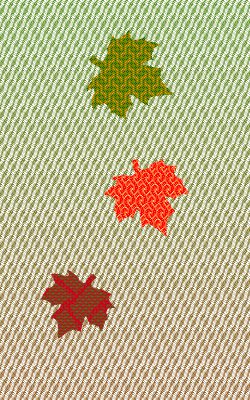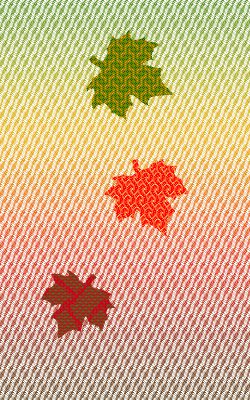I’ve started thinking about color gradients in the top layer of fabric, and produced these two samples:


I’m still debating which I like better. The green and brown emphasizes the leaves more, but is perhaps a little boring; the multicolored arrangement is much more lively, but starts to compete with the leaves (and possibly with the wearer?). To pull it off, I would have to use relatively low-chroma (“dull”) colors, to make the leaves look brighter by contrast.
The multicolor arrangement would also be a real pain in the butt to dye for. Each of those color transitions would probably require 20 or more shades to get the color transition smooth and unnoticeable; so now we’re talking 80 colors just to get a smooth color transition. Which also means winding 80 pirns and changing colors roughly every 3/4″ throughout a 60″ panel. And doing that four times: twice for the front, and twice for the back of the garment. It’s enough to make me contemplate an alternative, using a knitted blank to handle the color changes. That comes with its own problems, but it’s a lot quicker than sampling and then dyeing 80 shades!
The other problem is that Photoshop simulations really don’t adequately simulate the look of the finished piece. My early simulations suggested that a very pale brown would look best, but that just looked washed out. There is, practically speaking, no way to know without weaving samples…laborious beyond belief, but I don’t see any way around it. I’m rather dreading the prospect, though.
So I’ll toss out the question to you, gentle reader: which do you prefer? The green to brown transition, or the more multicolored one? Or something else entirely?
I’d love to hear your thoughts!

Hi Tien ~
I prefer the more multi-colored option. Seems to me that it is more lively and interesting than the other. Having followed your blog for quite some time, I’m confident that you can pull it off. the knitting blank — or something along those lines — seems a likely solution, and certainly a LOT less work for you.
I agree with Anne. The multiple colors really have more depth and movement. A painted knitted blank was the first thing I thought of when you mentioned 80 pirns. In any event, I can’t wait to see what you come up with next.
Can you reverse the background colors in the bottom one, going red-to-green from top to bottom instead of green-to-red? That would keep the excitement but have the complement of the leaves always behind it. Just a thought…
Although your Kodachrome proves that you’re not afraid of the colors overpowering the wearer, I like the subtler background better. It doesn’t compete with the leaves as much.
I’m with Ann, I vote for the green to brown. Of course it depends on the exact shades of green and brown, to be warm, not dull.
Sample.
I know it’s all illusion, but I can see the leaves gently falling in the green to brown gradient, but on the brighter colored one, my eye gets stuck on the yellow and there’s no motion.
I know I said I would respond today. However, I need to sleep on it.
In the green to brown the focus is on the leaves, and in the multi-colour, the focus is on the background. Although I am never afraid of colour, I like the leaves on the green to brown background. Your work is always facinating. Looking forward to seeing more.
Barbara
I prefer the multi-colored background for two reasons. With the green to brown gradation, the green is nice but the brown just seems a little dull or lifeless to me. Also, the values of the green and brown seem identical. I think what grabs my eye with the multi-colored background isn’t necessarily the brighter colors but the sense of movement. Adding the lighter value yellow between the green and red makes for more interest. So for me, it may be the values more than the colors themselves.
how about trying a simulation with the multicolored background, starting with the yellow (omitting the green)? it might seem like autumn leaves drifting to the ground at sunset…